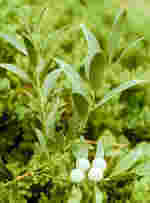 Foliage on a tree at the Univ. of Florida, Gainesville (Dan Skean 1985) (3). | Nageia nagi (Thunb.) O. Kuntze 1891Common NamesBroad-leaved podocarpus (3);Taxonomic notesSyn: Podocarpus nagi (Thunb.) Zoll. & Moritz. (5); Decussocarpus nagi de Laubenfels. Li (4) describes a Podocarpus formosana, synonyms for which include P. nagi var. angustifolia Sasaki 1928; P. nagi var. koshunensis Kanehira 1931; and P. koshunensis Kanehira 1936; that taxon is treated here pending more explicit information on the relative status of these synonyms. Silba (source uncertain) has described one variety, N. nagi var. formosensis (Dummer) Silba [syn: Podocarpus formosensis Dummer].Description"Evergreen trees. Leaves opposite or subopposite, coriaceous, ovate, ovate-lanceolate or elliptic, 6 cm. long; 2 cm. wide, midribs indistinct, many-nerved, bright green and shining on both surface, subsessile. Staminate flowers catkin-like, cone-shaped, axillary, 3-5 clustered. Seeds globose, about 1-1.5 cm. in diameter, bluish green and bloomy, without fleshy receptacles."Trunk bark blackish brown, irregularly flaky and 1eaving spline-shaped or somewhat rectangular flake-scars on trunks, flakes about 1.5 mm. thick, more or less woody; lenticels grayish brown, about 0.8 mm across, longitudinally sparsely arranged; outer bark about 0.3 mm. thick, membranous, cross-section of outer bark brown; phelloderm very conspicuous; inner bark about 7 mm. thick, pale yellowish white, fibrous, with flimsy white streaks of parenchymatous tissues; cambium and newly formed phloem colorless, more or less transparent. Freshly cut sapwood pale apricot yellow; wood rays thready, not very much distinct" (5). RangeS. China & Japan. Introduced and planted in Taiwan (5).Big TreeOldestDendrochronologyEthnobotanyObservationsRemarksCitations(1) Silba 1986.(2) Botanical Inventory Of Taiwan. (3) Albion University website. (4) Li 1975. (5) Liu 1970 (as Podocarpus nagi). |
[Nageia] [Podocarpaceae] [home] This page is from the Gymnosperm Database |